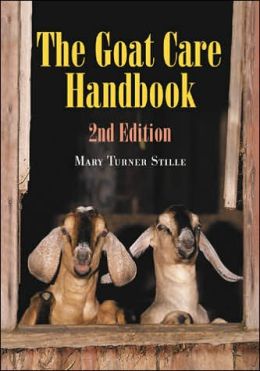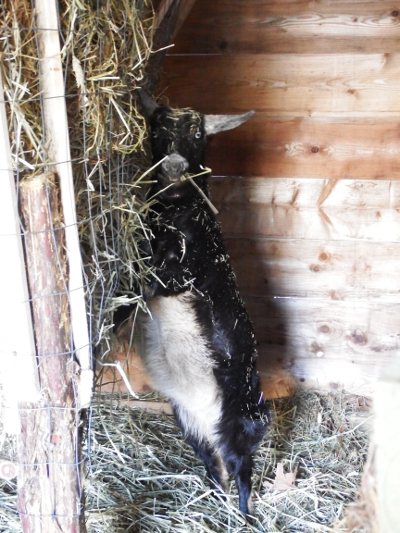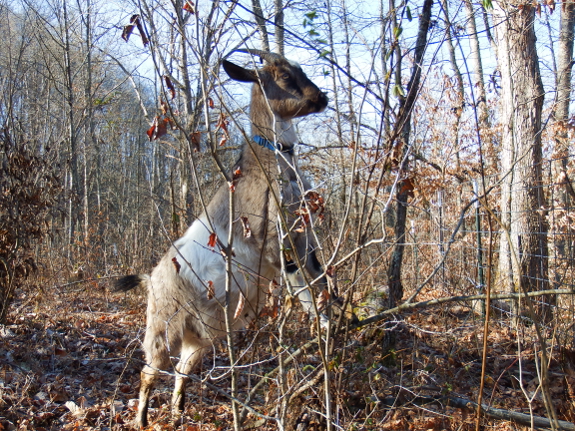
The Goat Care Handbook
 Whenever
I get excited or worried about a topic, I pick up a book to ease my
mind. I'm pretty excitable, so I read a lot...especially while waiting
for my first doe to give birth.
Whenever
I get excited or worried about a topic, I pick up a book to ease my
mind. I'm pretty excitable, so I read a lot...especially while waiting
for my first doe to give birth.
That said, I picked up Mary Turner Stille's The Goat Care Handbook
largely because I had read part of the text during a google search and
was impressed by her astute advice. "Don't trim the hooves of a pregnant
doe after the third month of gestation," she warns, "unless she is very
docile because her struggles may harm her and the unborn kids." Stille's firsthand experience from decades of goat care came through in that simple admonition, so I had to read the entire book.
And I'm glad I did since the text offered answers to other questions
that had been niggling against the back of my mind for weeks. For
example, I've often wondered how much time you'd have to allot to
goat-dining if you wanted to keep your herd penned up, giving them all
of their feed by taking them out into the woods to browse daily. Stille
actually kept goats in this manner for a while and found that her goats
required about an hour in the morning and an hour in the evening for
eating. In addition, she mentioned that she found the same grazing times
in pastured goats when she later had fences in place (with the
remainder of the day spent chewing cud, napping, and playing). I guess
my half-hour of honeysuckle herding (until we ran out last week) was making a bigger difference in our goats' dietary intakes than I'd assumed!
 Although
I've promised Mark not to lobby for any new livestock for at least a
couple of years, I was also intrigued by Stille's information about
combining goats with other animals. She wrote that a goat mixed in with a
flock of sheep makes the woolly livestock easier to handle since the
goat will come when you call and the sheep will follow. Similarly, one
calf mixed in with goats will eat the waste hay (which goats won't touch
once it hits the ground) and will keep the pasture more evenly mowed.
(Unrelatedly, but still interesting, Stille is a fan of deep bedding on a dirt floor for goats, unlike Pat Coleby,
although Stille does warn that bacteria can get into caprine hooves if
you're not careful to keep bedding dry on top and hooves well trimmed.)
Although
I've promised Mark not to lobby for any new livestock for at least a
couple of years, I was also intrigued by Stille's information about
combining goats with other animals. She wrote that a goat mixed in with a
flock of sheep makes the woolly livestock easier to handle since the
goat will come when you call and the sheep will follow. Similarly, one
calf mixed in with goats will eat the waste hay (which goats won't touch
once it hits the ground) and will keep the pasture more evenly mowed.
(Unrelatedly, but still interesting, Stille is a fan of deep bedding on a dirt floor for goats, unlike Pat Coleby,
although Stille does warn that bacteria can get into caprine hooves if
you're not careful to keep bedding dry on top and hooves well trimmed.)

In the end, I'd still recommend Storey's Guide to Raising Dairy Goats as the first book for most beginners to read. But The Goat Care Handbook would make a good second read, especially if paired with Raising Goats Naturally. Of
course, the real test will be to see which goat book, if any, stays on
my shelf more than a year or two since I cull my collection just as
ruthlessly as Stille recommends culling your goats. Stay tuned to see
which goat book stands the test of time...more details to come in 2017.
Want more in-depth information? Browse through our books.
Or explore more posts by date or by subject.
About us: Anna Hess and Mark Hamilton spent over a decade living self-sufficiently in the mountains of Virginia before moving north to start over from scratch in the foothills of Ohio. They've experimented with permaculture, no-till gardening, trailersteading, home-based microbusinesses and much more, writing about their adventures in both blogs and books.
Want to be notified when new comments are posted on this page? Click on the RSS button after you add a comment to subscribe to the comment feed, or simply check the box beside "email replies to me" while writing your comment.
